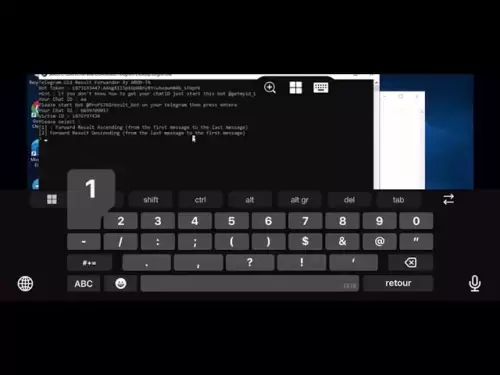-
 Bitcoin
Bitcoin $107,031.8162
-2.52% -
 Ethereum
Ethereum $2,621.4228
-2.51% -
 Tether USDt
Tether USDt $1.0001
-0.04% -
 XRP
XRP $2.2397
-4.12% -
 BNB
BNB $685.2354
-0.57% -
 Solana
Solana $169.7513
-4.44% -
 USDC
USDC $0.9998
0.01% -
 Dogecoin
Dogecoin $0.2178
-4.24% -
 TRON
TRON $0.2742
-0.79% -
 Cardano
Cardano $0.7353
-3.78% -
 Sui
Sui $3.5357
-4.72% -
 Hyperliquid
Hyperliquid $32.8671
-11.41% -
 Chainlink
Chainlink $15.3525
-3.68% -
 Avalanche
Avalanche $22.8728
-2.22% -
 Stellar
Stellar $0.2798
-3.35% -
 Toncoin
Toncoin $3.4068
13.49% -
 UNUS SED LEO
UNUS SED LEO $9.1041
2.33% -
 Shiba Inu
Shiba Inu $0.0...01398
-3.54% -
 Bitcoin Cash
Bitcoin Cash $405.5943
-3.07% -
 Hedera
Hedera $0.1818
-4.36% -
 Litecoin
Litecoin $93.6910
-3.21% -
 Polkadot
Polkadot $4.4305
-2.75% -
 Monero
Monero $349.3281
-8.45% -
 Bitget Token
Bitget Token $5.1994
-3.07% -
 Pepe
Pepe $0.0...01346
-3.80% -
 Dai
Dai $0.9998
0.01% -
 Pi
Pi $0.7211
-3.95% -
 Ethena USDe
Ethena USDe $1.0007
0.00% -
 Uniswap
Uniswap $6.6488
1.82% -
 Aave
Aave $261.6923
-5.14%
What does the long-term sideways movement of the TRIX line represent? How to predict the breakthrough direction?
Long-term sideways movement of the TRIX line indicates market consolidation; use additional indicators and sentiment analysis to predict breakout direction.
May 25, 2025 at 11:08 pm
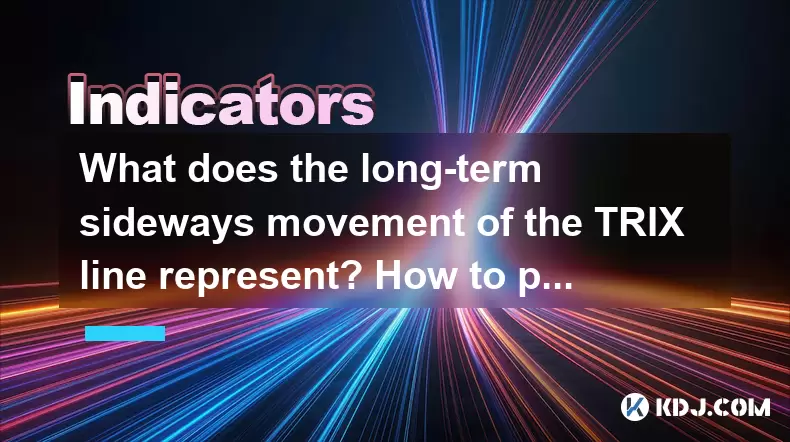
The TRIX (Triple Exponential Average) indicator is a momentum oscillator used in technical analysis to identify overbought or oversold conditions in the market. When the TRIX line exhibits long-term sideways movement, it signifies a period of consolidation or indecision in the market. This article will delve into what this long-term sideways movement represents and provide strategies to predict the breakthrough direction.
Understanding Long-Term Sideways Movement of the TRIX Line
The TRIX line is calculated using a triple-smoothed moving average of the price, which helps to filter out minor fluctuations and focus on the underlying trend. When the TRIX line moves sideways over an extended period, it indicates that the market is in a state of equilibrium, with neither buyers nor sellers gaining significant control.
Long-term sideways movement of the TRIX line suggests that the asset's price is consolidating within a range. This can be a sign of market indecision, where traders are waiting for a clear signal before making their next move. During this period, the market may be digesting recent gains or losses, and a breakout is often anticipated.
Factors Contributing to Long-Term Sideways Movement
Several factors can contribute to the long-term sideways movement of the TRIX line:
- Market Sentiment: If investors are uncertain about the future direction of the market, they may hold off on making significant trades, leading to a period of consolidation.
- Economic Indicators: News and economic reports can influence market sentiment. If there is no clear direction from these indicators, the market may remain in a sideways trend.
- Volume and Liquidity: Low trading volume can result in a lack of momentum, causing the TRIX line to move sideways as there is insufficient buying or selling pressure to drive a trend.
Predicting the Breakthrough Direction
Predicting the breakthrough direction during a long-term sideways movement of the TRIX line requires a combination of technical analysis and market insight. Here are some strategies to help traders anticipate the direction of the breakout:
Using Additional Technical Indicators
Combining the TRIX with other technical indicators can provide a more comprehensive view of the market. Some useful indicators include:
- Moving Averages: Observing the interaction between short-term and long-term moving averages can help identify potential breakout directions. If the short-term moving average crosses above the long-term moving average, it may signal an upcoming bullish breakout.
- Relative Strength Index (RSI): The RSI can help identify overbought or oversold conditions. A divergence between the RSI and price action can signal a potential reversal or breakout.
- Bollinger Bands: These bands can indicate volatility and potential breakout points. If the price moves outside the Bollinger Bands, it may signal the start of a new trend.
Analyzing Market Sentiment
Market sentiment can play a crucial role in predicting the breakthrough direction. Traders can use various tools to gauge sentiment, such as:
- Social Media Analysis: Monitoring social media platforms and forums can provide insights into the general mood of the market. A sudden increase in positive or negative sentiment can precede a breakout.
- News and Events: Keeping an eye on upcoming events and news releases can help traders anticipate market reactions. For example, a positive regulatory announcement may lead to a bullish breakout.
- Sentiment Indicators: Tools like the Fear and Greed Index can provide a snapshot of the overall market sentiment, helping traders predict potential movements.
Observing Volume and Liquidity
Volume and liquidity are critical factors in predicting breakouts. Here's how to use them effectively:
- Volume Spikes: A significant increase in trading volume can signal the start of a breakout. If the volume spikes during a period of sideways movement, it may indicate that a new trend is forming.
- Liquidity Levels: High liquidity can facilitate smoother breakouts, as there are more participants in the market. Conversely, low liquidity can lead to false breakouts, so it's essential to monitor liquidity levels.
Practical Steps to Predict Breakthrough Direction
To effectively predict the breakthrough direction, traders can follow these steps:
Monitor the TRIX Line: Keep a close eye on the TRIX line for any signs of movement outside the long-term sideways range. A breakout above or below this range can signal the start of a new trend.
Use Multiple Indicators: Combine the TRIX with other indicators like moving averages, RSI, and Bollinger Bands to get a more comprehensive view of the market. Look for confirmations from multiple indicators before making a trade.
Analyze Market Sentiment: Regularly check social media platforms, news sources, and sentiment indicators to gauge the overall mood of the market. A shift in sentiment can precede a breakout.
Track Volume and Liquidity: Monitor trading volume and liquidity levels. A significant increase in volume or a change in liquidity can signal an upcoming breakout.
Set Up Alerts: Use trading platforms to set up alerts for key levels and indicators. This can help traders react quickly to potential breakouts.
Backtest Strategies: Before applying any strategy, backtest it using historical data to see how it would have performed in past market conditions. This can help refine the approach and increase the chances of success.
Case Study: TRIX Sideways Movement in Bitcoin
To illustrate the concepts discussed, let's look at a hypothetical case study involving Bitcoin (BTC). Suppose the TRIX line for BTC has been moving sideways for several months. During this period, the price of BTC has been consolidating within a range of $20,000 to $25,000.
Technical Indicators: The RSI is hovering around 50, indicating a neutral market. The Bollinger Bands are tight, suggesting low volatility. However, the 50-day moving average is starting to cross above the 200-day moving average, which could signal an upcoming bullish breakout.
Market Sentiment: Social media sentiment analysis shows a growing optimism among investors, with many discussing the potential for a new bull run. A recent positive regulatory announcement has further boosted sentiment.
Volume and Liquidity: Trading volume has been steady but is starting to increase. Liquidity levels are high, indicating that there are enough market participants to facilitate a smooth breakout.
Based on these observations, a trader might predict an upcoming bullish breakout. They could set up buy orders near the top of the consolidation range ($25,000) and use stop-loss orders to manage risk. Monitoring the TRIX line for a move above the sideways range would confirm the breakout, prompting the trader to enter the position.
Frequently Asked Questions
Q: Can the TRIX line be used in conjunction with other momentum indicators?
A: Yes, the TRIX line can be effectively used alongside other momentum indicators like the MACD (Moving Average Convergence Divergence) and the Stochastic Oscillator. These indicators can provide additional confirmation of potential breakouts and help traders make more informed decisions.
Q: How often should I check the TRIX line for signs of a breakout?
A: The frequency of checking the TRIX line depends on your trading style. Day traders might check it multiple times a day, while swing traders might review it daily or weekly. Setting up alerts for key levels can help ensure you don't miss potential breakouts.
Q: What are the risks of trading during a long-term sideways movement of the TRIX line?
A: Trading during a long-term sideways movement carries the risk of false breakouts and whipsaws, where the price briefly breaks out of the range only to revert back. To mitigate these risks, use stop-loss orders and consider waiting for confirmation from multiple indicators before entering a trade.
Q: Can the TRIX line be applied to different time frames?
A: Yes, the TRIX line can be applied to various time frames, from short-term intraday charts to long-term weekly or monthly charts. The choice of time frame should align with your trading strategy and goals.
Disclaimer:info@kdj.com
The information provided is not trading advice. kdj.com does not assume any responsibility for any investments made based on the information provided in this article. Cryptocurrencies are highly volatile and it is highly recommended that you invest with caution after thorough research!
If you believe that the content used on this website infringes your copyright, please contact us immediately (info@kdj.com) and we will delete it promptly.
- Bitcoin (BTC) Price Prediction: Next Target $112,000 as Double Bottom Pattern Plays Out
- 2025-05-29 04:35:20
- The launch of the first XRP futures ETF (XRPI) marks a major step forward for institutional crypto adoption.
- 2025-05-29 04:35:19
- Quant (QNT) maintains a recovery trend, with the layer 2.5 network announcement for institutions and decentralized finance (DeFi)
- 2025-05-29 04:30:13
- With the conclusion of Crypto Dinner, Trump Coin price could continue crashing exacerbating its 20% dip caused by whale sell-offs
- 2025-05-29 04:30:13
- Uniswap's UNI Price Aims Fresh Increase
- 2025-05-29 04:25:13
- Monero (XMR) Returns to Top 25 Cryptocurrencies by Market Capitalization
- 2025-05-29 04:25:13
Related knowledge
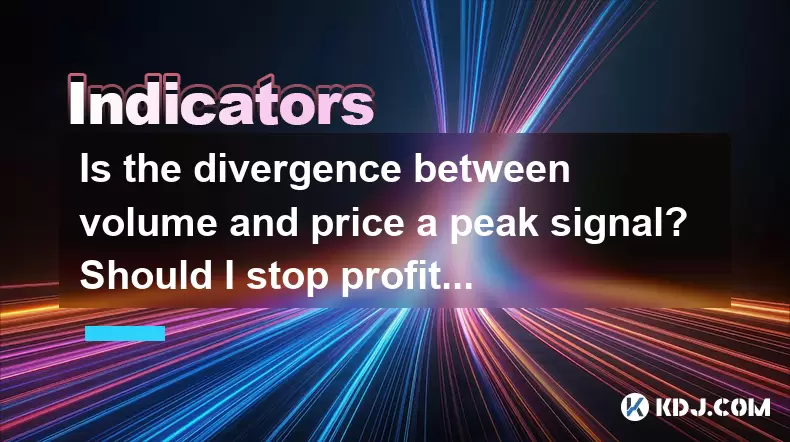
Is the divergence between volume and price a peak signal? Should I stop profit or hold?
May 29,2025 at 04:43am
Is the divergence between volume and price a peak signal? Should I stop profit or hold? In the world of cryptocurrencies, traders often look for signals that can indicate potential peaks or troughs in market trends. One such signal that traders frequently monitor is the divergence between volume and price. This phenomenon occurs when the trading volume ...
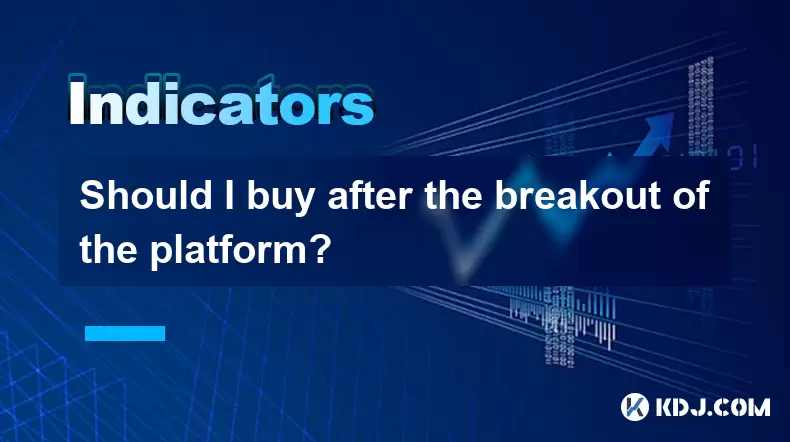
Should I buy after the breakout of the platform?
May 29,2025 at 04:35am
Understanding Breakouts in CryptocurrencyBreakouts in the cryptocurrency market occur when the price of a digital asset moves above a defined resistance level or below a support level, often leading to increased volatility and trading activity. A breakout can signal the start of a new trend, either bullish or bearish, depending on the direction of the p...
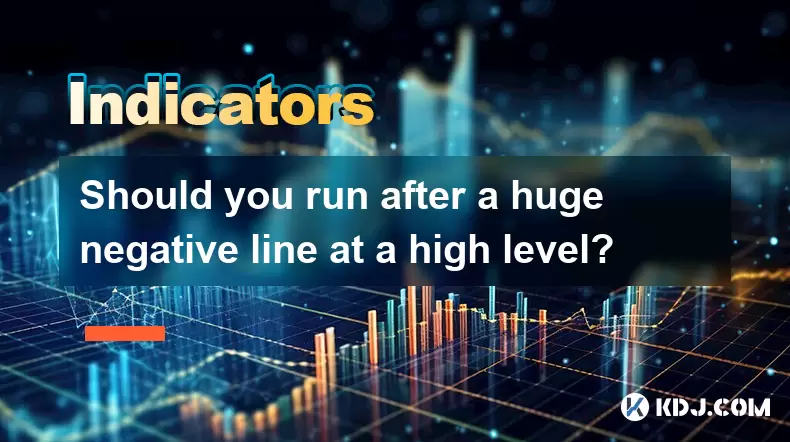
Should you run after a huge negative line at a high level?
May 29,2025 at 04:21am
Should you run after a huge negative line at a high level? When navigating the volatile world of cryptocurrencies, one of the most challenging decisions traders face is whether to chase a significant price drop after a high. A huge negative line at a high level often signals a sharp reversal in market sentiment, and understanding how to react to such mo...
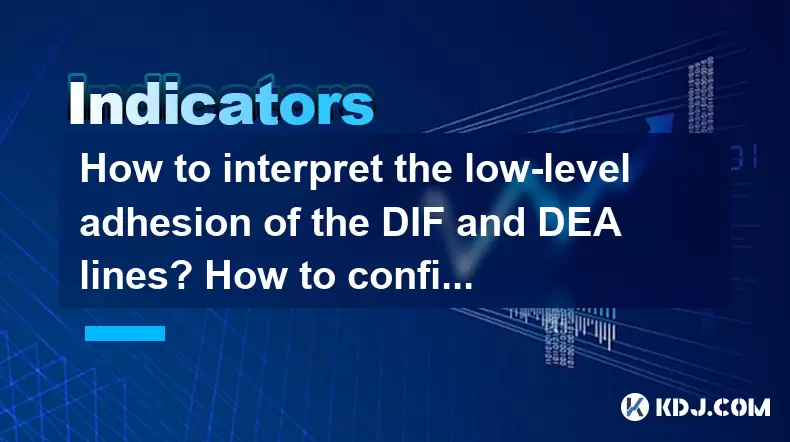
How to interpret the low-level adhesion of the DIF and DEA lines? How to confirm the direction selection signal?
May 29,2025 at 02:49am
Understanding the low-level adhesion of the DIF and DEA lines in the context of cryptocurrency trading involves delving into the specifics of the Moving Average Convergence Divergence (MACD) indicator. The MACD is a trend-following momentum indicator that shows the relationship between two moving averages of a cryptocurrency's price. The DIF line, also ...
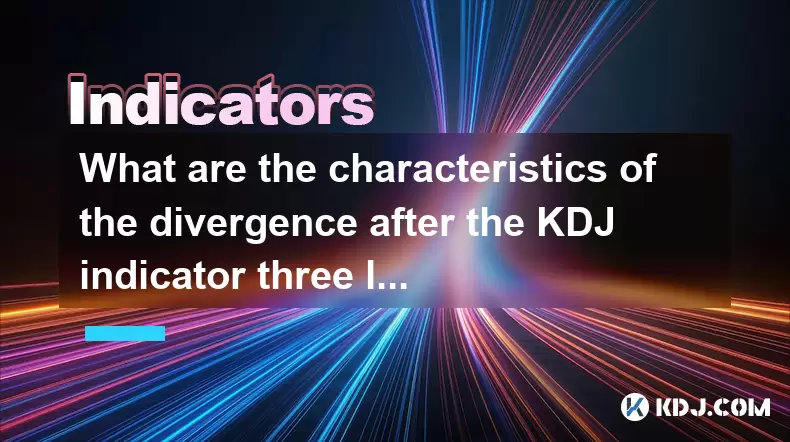
What are the characteristics of the divergence after the KDJ indicator three lines merge into one? What are the direction selection signals?
May 29,2025 at 03:14am
The KDJ indicator is a popular tool used in the cryptocurrency trading community to identify potential trend reversals and to gauge the momentum of price movements. When the three lines of the KDJ indicator—namely the K line, D line, and J line—merge into one, it often signifies a significant event in the market. This phenomenon is known as a divergence...
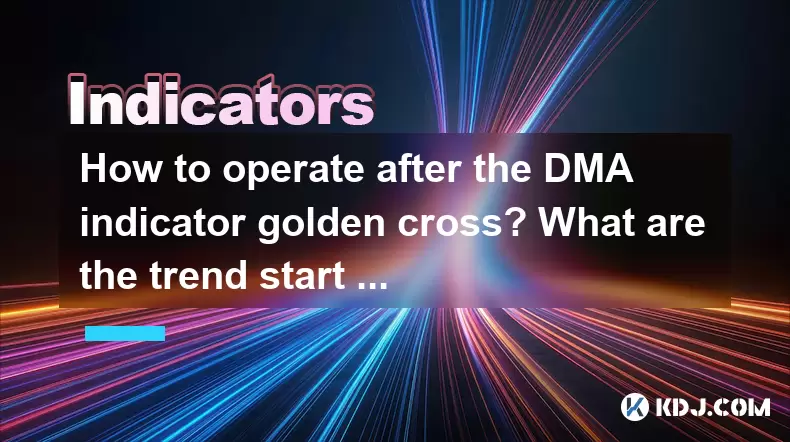
How to operate after the DMA indicator golden cross? What are the trend start signals?
May 29,2025 at 12:21am
How to Operate After the DMA Indicator Golden Cross? What Are the Trend Start Signals? The DMA (Dual Moving Average) indicator is a popular tool among cryptocurrency traders for identifying potential trend changes and entry points. A golden cross on the DMA indicator occurs when a shorter-term moving average crosses above a longer-term moving average, s...

Is the divergence between volume and price a peak signal? Should I stop profit or hold?
May 29,2025 at 04:43am
Is the divergence between volume and price a peak signal? Should I stop profit or hold? In the world of cryptocurrencies, traders often look for signals that can indicate potential peaks or troughs in market trends. One such signal that traders frequently monitor is the divergence between volume and price. This phenomenon occurs when the trading volume ...

Should I buy after the breakout of the platform?
May 29,2025 at 04:35am
Understanding Breakouts in CryptocurrencyBreakouts in the cryptocurrency market occur when the price of a digital asset moves above a defined resistance level or below a support level, often leading to increased volatility and trading activity. A breakout can signal the start of a new trend, either bullish or bearish, depending on the direction of the p...

Should you run after a huge negative line at a high level?
May 29,2025 at 04:21am
Should you run after a huge negative line at a high level? When navigating the volatile world of cryptocurrencies, one of the most challenging decisions traders face is whether to chase a significant price drop after a high. A huge negative line at a high level often signals a sharp reversal in market sentiment, and understanding how to react to such mo...

How to interpret the low-level adhesion of the DIF and DEA lines? How to confirm the direction selection signal?
May 29,2025 at 02:49am
Understanding the low-level adhesion of the DIF and DEA lines in the context of cryptocurrency trading involves delving into the specifics of the Moving Average Convergence Divergence (MACD) indicator. The MACD is a trend-following momentum indicator that shows the relationship between two moving averages of a cryptocurrency's price. The DIF line, also ...

What are the characteristics of the divergence after the KDJ indicator three lines merge into one? What are the direction selection signals?
May 29,2025 at 03:14am
The KDJ indicator is a popular tool used in the cryptocurrency trading community to identify potential trend reversals and to gauge the momentum of price movements. When the three lines of the KDJ indicator—namely the K line, D line, and J line—merge into one, it often signifies a significant event in the market. This phenomenon is known as a divergence...

How to operate after the DMA indicator golden cross? What are the trend start signals?
May 29,2025 at 12:21am
How to Operate After the DMA Indicator Golden Cross? What Are the Trend Start Signals? The DMA (Dual Moving Average) indicator is a popular tool among cryptocurrency traders for identifying potential trend changes and entry points. A golden cross on the DMA indicator occurs when a shorter-term moving average crosses above a longer-term moving average, s...
See all articles





















